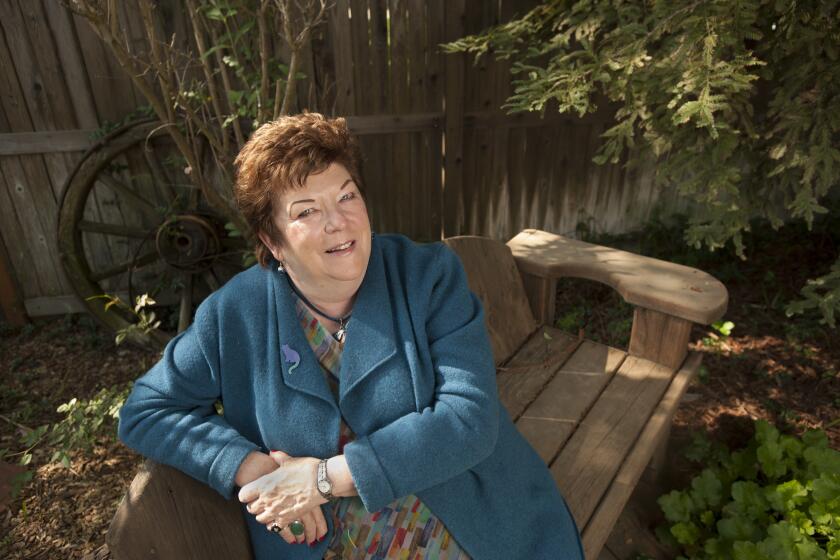Venice mural recalling the Doors hits an unexpected sour note
From Venice Beach comes a seemingly simple tale of art imitating art, complicated by the ghost of a rock ‘n’ roll legend.
In early 1969, a pioneering Venice muralist thought it would be a kick to paint a trompe l’oeil street scene on the back exterior wall of his studio, so that if an observer stood across the street and looked left and right he’d see the same view, more or less.
From a distance that allowed ample perspective, artist Victor Henderson photographed a motley stretch of structures just down the block, with a slip of the calm Pacific in the background. Prominently featured on the weathered-brick building in the foreground were two advertisements: “Wash 15 cents Fluff Dry 5 cents” and a red-and-white “Drink Coca-Cola” logo. The golden glow of a setting sun was reflected in the windows.
Henderson, now 73, spent a month crafting the mural, using the photograph as a guide.
“There was a tremendous sense of excitement and newness to that work,” he said.
Ten months later, in December 1969, Henry Diltz, a folk musician turned photographer fresh from shooting that summer’s Woodstock festival, spent a day strolling around Venice with the Doors, taking photos to publicize the group’s soon-to-be-released “Morrison Hotel” album.
When the rock quartet happened upon Henderson’s mural, they posed … and posed. In some frames, they’re shown using a discarded green mannequin as a prop.
Frontman Jim Morrison, in a white shirt, jeans and navy jacket, looks like a chubby-cheeked teen. Guitarist Robby Krieger, wearing a brown jacket and sunglasses, leans against the mural, one foot crossed over the other in the trash-strewn vacant lot. Keyboardist Ray Manzarek stands with his hands in the front pockets of his jeans. Drummer John Densmore sports brown sandals with dark socks, a white denim jacket, dark bell bottoms and a navy bandanna tied jauntily around his neck.
They look right at home in Venice, then a grungy, thinly populated, crime-addled community popular with poets, artists and drunks.
Diltz’s color and black-and-white photos of the Doors and the mural became a sensation among rock fans. To this day, Doors devotees from around the world make pilgrimages to the site.
Not long ago, Ralph Ziman, owner of the Brooks Avenue building where Henderson once had his studio, came across one of Diltz’s photos. His wife, artist Maria Greenshields-Ziman, recognized the mural from the remnants on their building. Time, taggers and sea air had taken their toll. The lower 10 feet or so had been painted over to hide graffiti.
A filmmaker and music video director who grew up in South Africa, Ziman, 50, put out the word that he needed a muralist to reproduce the artwork. A friend put him in touch with Clinton Bopp, a New Zealand-born painter and sculptor who lives in Santa Monica Canyon and, coincidentally, knows Diltz.
Ziman and Bopp discussed the idea for nearly a year. A Doors fan since adolescence, Bopp suggested a twist on the original: Why not incorporate Morrison and his bandmates into the mural?
Ziman embraced the idea.
Workers sandblasted the wall and primed it. Then, the first weekend in August, Bopp brought his extension ladder and plastic containers of hand-mixed paints to Brooks Avenue, where he worked from early morning till fading light on the mural. He used small brushes to paint in the thin lines separating bricks.
“It’s a great wall and a great location,” Bopp said. But painting bricks onto bricks — and on an angle, to capture the perspective — was quite a challenge. “You don’t have straight lines,” he said, “because of the bumps and grooves.” He has relied on his level, lots of measurements and his eyeball.
But then things got a little sticky. The day before Bopp was to start sketching the Doors into the drawing, he had a visit from Henderson, who had gotten wind of the project and popped by to see for himself. Bopp was thrilled to meet Henderson. Henderson was not so happy.
For starters, he was disturbed that his mural had been obliterated. Under California law, a building owner who wants to destroy or modify a work of art must notify the artist and allow 90 days for the artist to remove the work. Moreover, Henderson, who had known Morrison and his bandmates, said he did not want the Doors painted into the mural, mainly because, in his view, his friend Morrison wouldn’t have wanted his likeness commercialized in that way.
The issue of rights in this case strikes Brooke Oliver, an arts attorney in San Francisco, as a “hall of mirrors.” The original artist did not have a copyright per se, but he has — or had — so-called moral rights to the work. Photographer Diltz has rights to his photos. The Doors have rights to their own likenesses. (Morrison died in 1971; Manzarek, in May.)
“And then you have the property owner,” Oliver said, “who is probably not aware of all of these sets of rights that relate to this art on this building.” Indeed, Ziman said, that was the case.
Reason prevailed. Ziman immediately agreed not to incorporate the Doors (although Bopp is considering transferring the Doors’ images onto metal or cardboard that could be stationed in front of the mural for the occasional photo). Henderson has asked an archivist who knew the mural to consult with Bopp on colors. (The reproduction appears to be much more vibrant than the original.)
“Victor’s the artist,” Ziman said. “I will, no matter what, respect his wishes.”
When told of the mural dispute, the Doors’ Densmore recalled the long-ago publicity shoot and the band’s Venice years. “We grew up in Venice,” he said. “That’s where we wrote all those songs … ‘Light My Fire,’ ‘Moonlight Drive,’ ‘Break on Through (to the Other Side).’”
What would be so wrong, he mused, with including the Doors in the mural?
More to Read
Start your day right
Sign up for Essential California for news, features and recommendations from the L.A. Times and beyond in your inbox six days a week.
You may occasionally receive promotional content from the Los Angeles Times.







